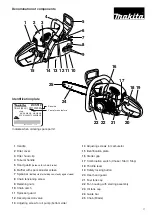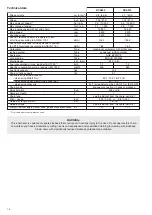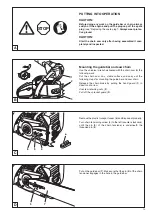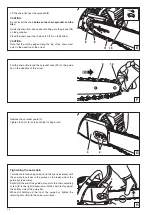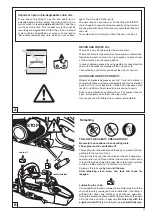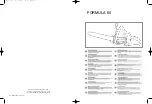
11
13
To avoid kickback
The best protection from personal-injury that may
result from kickback is to avoid kickback situations:
1.
Hold the chain saw firmly with both hands and
maintain a secure grip.
2.
Be aware of the location of the guide bar nose at
all times.
3.
Never bring the nose of the guide bar in contact
with any object. Do not cut limbs with the nose of
the guide bar. Be especially careful with small,
tough limbs, small size brush and saplings which
may easily catch the chain.
4.
Don’t overreach.
5.
Don’t cut above shoulder height.
6.
Begin cutting and continue at full throttle.
7.
Cut only one log at a time.
8.
Use extreme caution when re-entering a previous
cut.
9.
Do not attempt plunge cuts (see page 14) if you
are not experienced with these cutting techniques.
10.
Be alert for shifting of the log or other forces that
may cause the cut to close and pinch the chain.
11.
Maintain saw chain properly. Cut with a correctly
sharpened, properly tensioned chain at all times.
12.
Stand to the side of the cutting path of the chain
saw.
Many factors influence the occurence and force of
the kickback reaction. The type of bar and saw chain
you use is a factor in the force of the kickback reaction.
The speed of contact at which the cutter contacts
the object.
Kickback force increase with the rate of impact.
The contact angle between the nose of the bar
and the foreign object
(fig. 11).
Kickback is most pronounced in the upper quadrant
of the bar nose.
MAKITA chain types are designed to reduce kickback
forces.
The depth gauges:
Improper lowering of the depth gauges also increases
the risk of a kickback.
Saw chain cutter sharpness:
WARNING!
A dull improperly sharpened chain may increase
the risk of kickback. Always cut with a properly
sharpened chain.
Devices for reducing the risk of kickback injury
MAKITA have developed a special chain brake to
reduce the risk of kickbacks.
This chain brake increases the safety factor on the
job, e.g. when the saw suddenly bucks upwards the
chain stops rotating within a fraction of a second. A
deflection guard on the disengaging lever of the chain
brake and a scoop rear handle ensure that the opera-
tor’s hands are fully protected at all times.
Kickback tendency increases as the radius or size of
the guide bar nose increases. MAKITA have devel-
oped guide bars with small nose radius, to reduce the
kickback tendency.
WARNING!
No chain brake prevents kickback.
These brakes are designed only to stop the chain,
if activated.
To ensure a proper operation of the chain brake, it
must be properly maintained. Furthermore, there
must be a sufficient distance between the operator
and the bar to ensure that the chain brake has
sufficient time to activate and stop the chain before
potential contact with the operator.

















